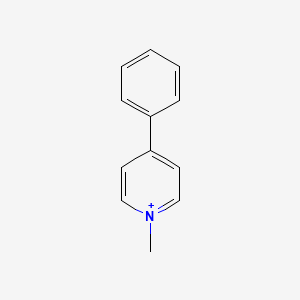Ferroptosis-centered Drug Response Information
General Information of the Drug (ID: ferrodrug0276)
| Name |
Cyperquat
|
||||
|---|---|---|---|---|---|
| Synonyms |
Cyperquat; MPP+; 1-METHYL-4-PHENYLPYRIDINIUM; N-Methyl-4-phenylpyridine; 48134-75-4; N-Methyl-4-phenylpyridinium ion; 1-methyl-4-phenylpyridin-1-ium; N-Methyl-4-phenylpyridinium; Pyridinium, 1-methyl-4-phenyl-; CHEBI:641; R865A5OY8J; Pyridinium,1-methyl-4-phenyl-; Cyperquat [ANSI]; 1 Methyl 4 Phenylpyridinium; CCRIS 2187; 1-Methyl-4-phenylpyridinium Ion; CYPERQUAT ION; BRN 1618932; CYPERQUAT CATION; CYPERQUAT [ISO]; Cyperquat [ANSI:ISO]; UNII-R865A5OY8J; SCHEMBL37321; CHEMBL311617; GTPL4568; DTXSID4058106; BDBM81945; CAS_39484; NSC_39484; 5-20-07-00550 (Beilstein Handbook Reference); Q161645; WRF
Click to Show/Hide
|
||||
| Status |
Investigative
|
||||
| Drug Type |
Small molecular drug
|
||||
| Structure |
 |
||||
| Formula |
C12H12N+
|
||||
| IUPAC Name |
1-methyl-4-phenylpyridin-1-ium
|
||||
| Canonical SMILES |
C[N+]1=CC=C(C=C1)C2=CC=CC=C2
|
||||
| InChI |
InChI=1S/C12H12N/c1-13-9-7-12(8-10-13)11-5-3-2-4-6-11/h2-10H,1H3/q+1
|
||||
| InChIKey |
FMGYKKMPNATWHP-UHFFFAOYSA-N
|
||||
| PubChem CID | |||||
Full List of Ferroptosis Target Related to This Drug
Phospholipid hydroperoxide glutathione peroxidase (GPX4)
| In total 1 item(s) under this Target | |||||
| Experiment 1 Reporting the Ferroptosis-centered Drug Act on This Target | [1] | ||||
| Target for Ferroptosis | Marker/Suppressor | ||||
| Responsed Disease | Parkinson disease | ICD-11: 8A00 | |||
| Responsed Regulator | Thioredoxin (TXN) | Suppressor | |||
| Pathway Response | Fatty acid metabolism | hsa01212 | |||
| Ferroptosis | hsa04216 | ||||
| Apoptosis | hsa04210 | ||||
| Cell Process | Cell ferroptosis | ||||
| Cell apoptosis | |||||
| In Vitro Model | PC12 cells | Adrenal gland pheochromocytoma | Rattus norvegicus | CVCL_0481 | |
| SH-SY5Y cells | Neuroblastoma | Homo sapiens | CVCL_0019 | ||
| In Vivo Model |
Male C57BL/6 mice wild-type (WT), 8 weeks of age, were from Chongqing Medical University, China. Mice were divided into four groups (n = 10-13 per group), control group, MPTP group, h-Trx-1 Tg group, and h-Trx-1 Tg + MPTP group. Control and h-Trx-1 Tg groups were administered saline only. For the Trx-1 knockdown experiment, mice were divided into six groups (n = 10-13 per group), control + saline group, control + MPTP group, AAV9-vehicle + saline group, AAV9-vehicle + MPTP group, AAV9-shRNA-mTrx-1 + saline group, and AAV9-shRNA-mTrx-1 + MPTP.
Click to Show/Hide
|
||||
| Response regulation | 1-methyl-4-phenylpyridinium (Cyperquat) decreased cell viability, GPX4, and Trx-1 (TXN). The decreased GPX4 and GSH, and increased ROS were inhibited by Fer-1 and Trx-1 overexpression. Trx-1 reversed the decreases of GPX4 and tyrosine hydroxylase (TH) induced by MPTP in the substantia nigra pars compacta (SNpc). Trx-1 inhibits ferroptosis in parkinson's disease through regulating GPX4 and GSH. | ||||
Cystine/glutamate transporter (SLC7A11)
| In total 1 item(s) under this Target | ||||
| Experiment 1 Reporting the Ferroptosis-centered Drug Act on This Target | [2] | |||
| Target for Ferroptosis | Suppressor | |||
| Responsed Disease | Parkinson disease | ICD-11: 8A00 | ||
| Responsed Regulator | Cellular tumor antigen p53 (TP53) | Driver | ||
| Pathway Response | Fatty acid metabolism | hsa01212 | ||
| Ferroptosis | hsa04216 | |||
| Cell Process | Cell ferroptosis | |||
| In Vitro Model | PC12 cells | Adrenal gland pheochromocytoma | Rattus norvegicus | CVCL_0481 |
| Response regulation | As a classic drug employed inin vitromodels of Parkinson's disease, 1-methyl-4-phenylpyridinium (MPP) can induce senescence in PC12 cells. The expression of the ferroptosis-related proteins ASCL4 was upregulated and FTH1 was downregulated, which promoted accumulation of lipid peroxides and eventually led to ferroptosis. By rescuing MPP-induced ferroptosis, cell senescence could be inhibited, and its molecular mechanism was related to a p53/SLC7A11/GPX4 signaling pathway. | |||
References
